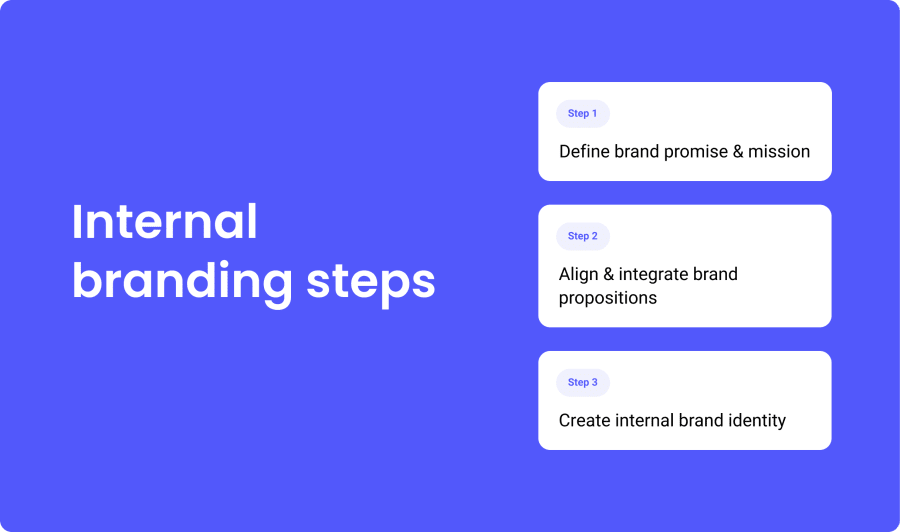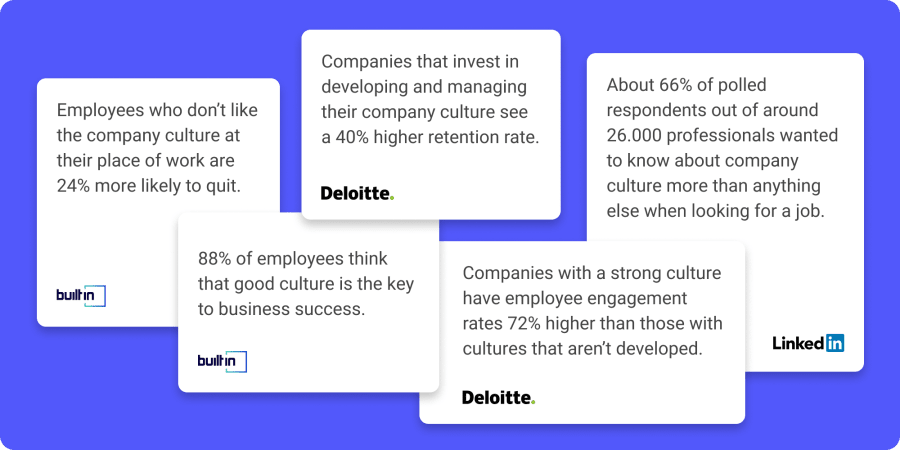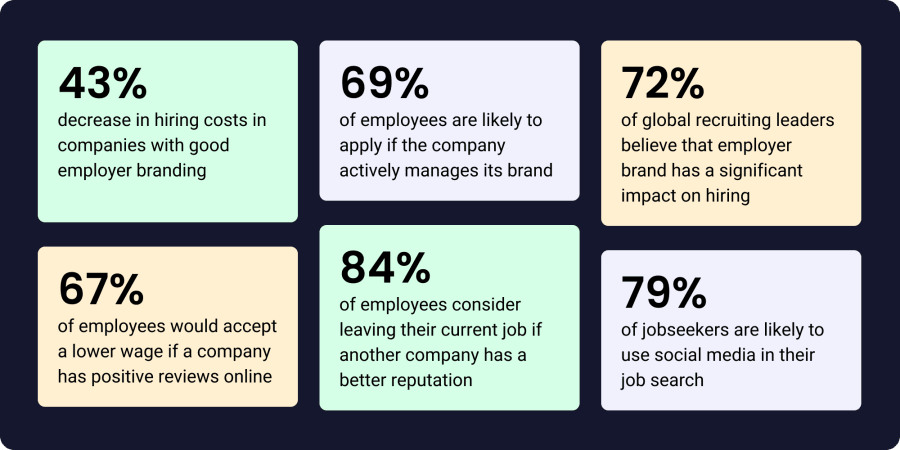In the IT industry, because of the high demand for new employees, it is very hard to find and retain the best talent. People often come and go, and with plenty of opportunities always on the horizon, a good organizational culture and values that the employees relate to can help them make the choice to stay.
You are probably thinking about how to create a brand that employees feel close to, and a culture where they feel comfortable, supported and thriving? Let’s delve into the topics of company culture, as well as internal and employer branding to help you better understand how this can help you attract and retain the right people.
Internal branding
Internal branding is the expression of the brand identity in staff selection and development. It is a representation of the brand strategy for the target group of employees. It is a corporate approach that allows and motivates employees to not only keep, but also "live" the brand promise.
As a result, the purpose of internal branding is to steer employees toward brand-specific behavior rather than forcing desirable job-specific behavior. In an ideal world, the client will interact with an employee who has internalized an externally-communicated brand promise and who communicates and acts in accordance with it.
Companies do this by involving employees in the brand development process, keeping them informed about the brand values and inspiring them to be enthusiastic about it in order to influence their behavior to support the brand.
Internal branding is very significant because businesses grow from the inside and contribute to higher sales.
The internal brand should also correlate to the external brand. This means that any branding and marketing strategy targeting potential customers and wider audiences cannot be significantly different from the one presented to the employees, stakeholders and other parties involved in the internal functioning of the organization.
When all employees understand and operate in accordance with a company's brand, it is safe to assume that the internal branding is successful and the brand's image is more recognizable and defined.
Members from various divisions, from the business’ leader to the new employees, should be involved as early as possible, rather than after the brand strategy is adopted.
The sooner employees are integrated, the better their grasp and engagement in the brand strategy will be, as well as their readiness to "live" the brand in their day-to-day operations. Apart from that, if people understand the meaning and benefits of the brand strategy, they can make a significant contribution to its success.
Here are some steps on where to start building a strong internal brand.

Define your brand promise and mission
Your company will lack a backstory or purpose that your employees can identify with if you don't have a clear direction.
By defining your organization's mission and brand promise, you will be able to communicate to your staff exactly what matters. By doing so, you increase your chance of outperforming your competitors.
Having a mission and values offers your employees a feeling of purpose in their work, shifting their perspective from "I'm just performing a job to make a living" to "I'm helping to build something bigger."
Make sure your value propositions are aligned and integrated
What your brand promises to both clients and employees, and what it is actually delivering should be the same thing. It is hard to make employees feel like they relate to the mission and values if the management and higher ranks of the organization don’t practice what they preach.
To draw a picture for you, I’ll use a hypothetical scenario. Imagine one of your company’s promises to be inclusive and diverse. Yet, your team doesn’t hire any employees from a different nationality, sexual orientation, race and religion outside of the majority in your country. It sounds hypocritical, doesn’t it?
Create an identity for your internal brand
Your external brand is established: it has its logo, fonts, brand colors, tone of voice, slogans, important claims, and overall look and feel. But your internal brand can be slightly distinctive. This will aid in the retention of your internal brand and help the employees feel a sense of belonging and visual coherence in their environment.
It's critical to connect your internal and external brands; this will help staff understand how the two are related and assure consistency. Giving your internal brand a personal touch will make it stand out and give employees a sense of ownership.
Company culture
The shared values, goals and everyday choices that your company and your employees identify with – and that characterize the organization – are seen as company culture.
Unlike an internal brand, company culture is something that evolves and builds up on its own, together with the people who work in the company. It is not something that you can necessarily strategically plan or write on paper. And it is far more than a ping pong table in the office or being able to bring your pet to work.
Company culture is a set of values and beliefs that the people in your company share. How do they feel about working there? What inspires them to do their job? Why did they choose this company, and not another one in this massive industry?
Truth be told, we spend more than a third of our lives working. And apart from choosing a job to make money and survive, we also do it because we correlate with the set of values or mission of the company we work for. When a workplace reflects our values and viewpoints, we are more likely to thrive in it, and more likely to perform well and not want to change our jobs every so often.
That is why company culture matters so much. In a competitive business such as software, salary and benefits alone don’t always help candidates choose a company. If they can afford to work for a company that respects and shares their values, they will do that instead.
How to create a winning team culture for modern tech teams
Learn to build and nurture cohesion, trust, and culture in hybrid and distributed teams.
Here are some statistics to paint a clearer picture:

A good corporate culture is one that all parties involved believe in. It's a way of life in the work community that enables you to live and breathe your basic ideals.
It is, however, the company's responsibility to ensure that every employee understands the expectations and performs in accordance with them. Curiosity, respect, teamwork, and staff health are all inherent in a genuinely strong internal culture.
Putting a strong emphasis on diversity and inclusion is also a great strategy to strengthen your company's culture.
How to inspire a unique culture to grow?
It's necessary to keep in mind that whether or not you cultivate it, company culture will be built. It is a natural occurrence when you put people together in the same environment.
As a result, begin by determining what type of organizational culture your company adheres to. The task of establishing organizational culture can then be divided into two categories: the large picture and the day-to-day endeavors.
Some of the most important things you should take into consideration when determining the model and steps of implementing a company culture are:
- Setting the company goals and values;
- Make sure you involve every employee;
- Check and iterate as your brand evolves;
- Improve employee engagement;
- Periodically check the best practices and draw lessons from employees;
- Be transparent with your employees;
- Conduct exit interviews to see what you need to work on as an employee.
Employer branding
The process of positioning and promoting a company as the best choice for employment to its target demographic is called employer branding.
Research suggests that 75% of job seekers review the company's reputation and employer brand before applying for a position. Even if they don't have a job, 80 percent of employers believe that the employer brand plays a big impact on their ability to acquire talent, and 50 percent of prospects don't want to work for a company with a terrible reputation.
These results show that employer branding not only aids, but also plays a critical role in attracting and retaining talent, makes the hiring process smoother and faster, and results in more engaged employees and cost cuts in the long run.
Statistics about employer branding according to Papirfly’s research:

Know that happy employees make the best brand ambassadors
Since a lot of people check for references and reviews on platforms like LinkedIn, Indeed and Glassdoor, good reviews from your employees matter a lot.
A happy employee is more likely to share company news, communicate their good experiences with peers, post job ads with their networks and even spread the word about your products and services.
So, a great employer branding strategy is to invest in employee engagement and experiences, so they can pull even more good talent into your pool.
Make sure HR and Marketing are on the same page
In employer branding, it’s very important that all the involved sectors of your company are on the same page. Many bigger employers have a specific marketing brand devoted only to employer branding, and their focus is to position the company as a desired workplace.
HR, however, should be involved in creating strategies and sharing their best practices with the marketing team. They are the key to the answer of what makes your company a good workplace, including what made people apply to job ads and what could be improved.
Don’t shy away from putting your employees under the spotlight
Finally, a very smart strategy that will help you improve employer branding is to put your current employees in the focus. Share their stories on social media such as LinkedIn, do interviews and case studies with them about why they love their work and appreciate them by sharing important milestones and achievements with your community.
They will be happy to work in a company that cares about their growth and share it with their own audience. This will help spread the word about your company even more.








